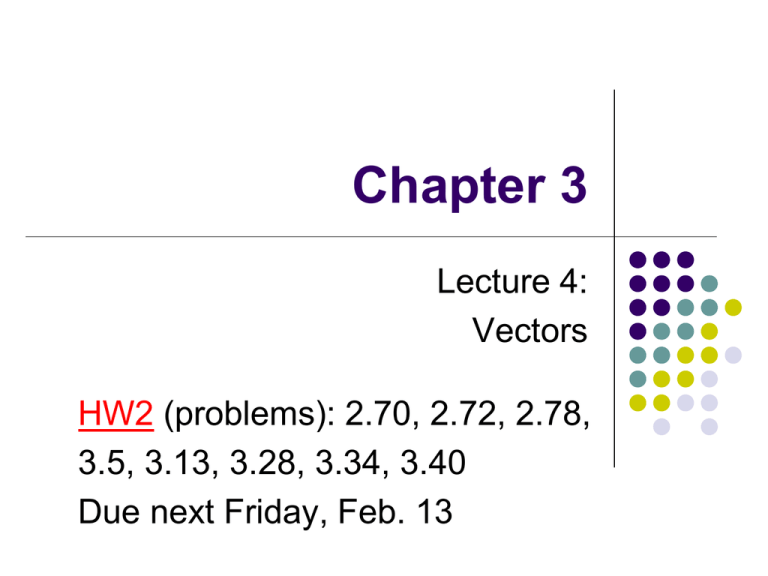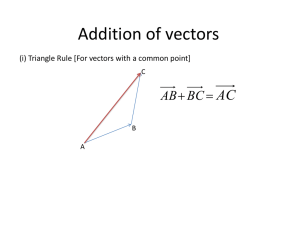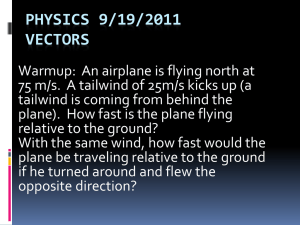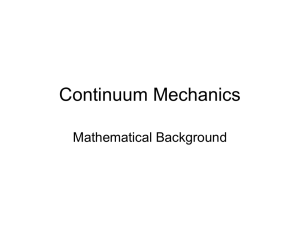Lect-4
advertisement

Chapter 3 Lecture 4: Vectors HW2 (problems): 2.70, 2.72, 2.78, 3.5, 3.13, 3.28, 3.34, 3.40 Due next Friday, Feb. 13 Kinematic Equations from Calculus Displacement equals the area under the velocity – time curve lim tn 0 v n tf xn tn v x (t )dt ti The limit of the sum is a definite integral 2-10: Graphical integration in motion analysis Starting from we obtain (vo= velocity at time t=0, and v1= velocity at time t = t1). Note that Similarly, we obtain (xo= position at time t = 0, and x1 = position at time t=t1), and Coordinate Systems Used to describe the position of a point in space Coordinate system consists of A fixed reference point called the origin Specific axes with scales and labels Instructions on how to label a point relative to the origin and the axes Cartesian Coordinate System Also called rectangular coordinate system x- and y- axes intersect at the origin Points are labeled (x,y) Polar to Cartesian Coordinates Based on forming a right triangle from r and q x = r cos q y = r sin q Cartesian to Polar Coordinates r is the hypotenuse and q an angle tanq y x r x2 y 2 q must be ccw from positive x axis for these equations to be valid Adding Vectors Graphically Continue drawing the vectors “tip-to-tail” The resultant is drawn from the origin of A to the end of the last vector Measure the length of R and its angle Use the scale factor to convert length to actual magnitude Adding Vectors Graphically, final When you have many vectors, just keep repeating the process until all are included The resultant is still drawn from the tail of the first vector to the tip of the last vector Adding Vectors, Rules When two vectors are added, the sum is independent of the order of the addition. This is the Commutative Law of Addition A B B A Adding Vectors, Rules cont. When adding three or more vectors, their sum is independent of the way in which the individual vectors are grouped This is called the Associative Property of Addition A BC A B C Negative of a Vector The negative of a vector is defined as the vector that, when added to the original vector, gives a resultant of zero Represented as A A A 0 The negative of the vector will have the same magnitude, but point in the opposite direction Subtracting Vectors Special case of vector addition If A B , then use A B Continue with standard vector addition procedure Components of a Vector, Introduction A component is a projection of a vector along an axis Any vector can be completely described by its components It is useful to use rectangular components These are the projections of the vector along the xand y-axes Unit Vectors A unit vector is a dimensionless vector with a magnitude of exactly 1. Unit vectors are used to specify a direction and have no other physical significance The symbols ˆi ,ˆj, and kˆ represent unit vectors They form a set of mutually perpendicular vectors in a righthanded coordinate system Remember, ˆi ˆj kˆ 1 Adding Vectors Using Unit Vectors Using R A B Then R Ax ˆi Ay ˆj Bx ˆi By ˆj R Ax Bx ˆi Ay By ˆj R Rx ˆi Ry ˆj and so Rx = Ax + Bx and Ry = Ay + By R R R 2 x 2 y q tan 1 Ry Rx 3.8: Multiplying vectors A. Multiplying a vector by a scalar Multiplying a vector by a scalar changes the magnitude but not the direction: a x s sa 3.8: Multiplying vectors B. Multiplying a vector by a vector: Scalar (Dot) Product The scalar product between two vectors is written as: It is defined as: Here, a and b are the magnitudes of vectors a and b respectively, and f is the angle between the two vectors. The right hand side is a scalar quantity. 3.8: Multiplying vectors C. Multiplying a vector with a vector: Vector (Cross) Product The vector product between two vectors a and b can be The right-hand rule allows us to find the direction of vector c. written as: The result is a new vector c, which is: Here a and b are the magnitudes of vectors a and b respectively, and f is the smaller of the two angles between a and b vectors. 3.8: Multiplying vectors; vector product in unit-vector notation: Note that: ˆi ˆi ˆj ˆj kˆ kˆ 0 ˆi ˆj ˆj ˆi kˆ ˆj kˆ kˆ ˆj ˆi kˆ ˆi ˆi kˆ ˆj Sample problem, vector product, unit vector notation








